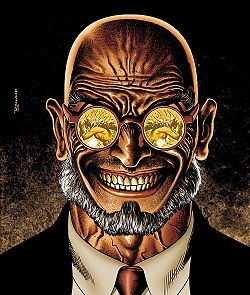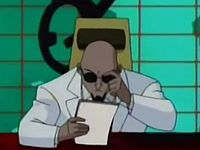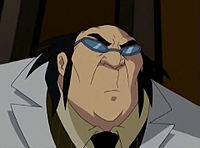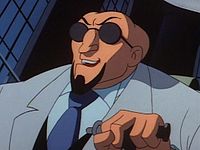- Hugo Strange
-
Not to be confused with Doctor Strange or Doc Strange.
Hugo Strange 
Art by Brian Bolland.Publication information Publisher DC Comics First appearance Detective Comics #36 (cover date February 1940)[1] Created by Bill Finger
Bob KaneIn-story information Alter ego Hugo Strange Abilities Genius-level intelligence,
Master practitioner of psychology, chemistry, and biology,
Peak physical conditioning (occasionally)Professor Hugo Strange is a fictional comic book supervillain appearing in books published by DC Comics, as an adversary of Batman. He first appeared in Detective Comics #36 (February 1940), and is one of Batman's first recurring villains, preceding the Joker and Catwoman by several months. He also one of Batman's first villains to realize that Batman is Bruce Wayne.
Contents
History
Pre-Crisis
Hugo Strange first appears as a scientist who uses a stolen "concentrated lightning" machine to generate a dense fog every night, allowing his gang to rob banks unseen, though he knows Batman poses a threat to him. Batman has been alerted to Strange due to a man murdered by a member of Strange's gang. He has heard of him prior to the story, and knows he is a master criminal. The crooks are apprehended. Strange is furious and vows to set a trap for Batman at the next target on the list. When the Batman arrives, over a dozen men are waiting for him. Despite a valiant fight, he succumbs to a whack on the head with a blackjack. He wakes up in Strange's lair. The furious Professor actually hangs Batman from his wrists and lashes him with a whip, until Batman breaks the ropes with pure strength of muscle, gasses the room, and tackles Strange, who is jailed but plans to escape. In his second appearance he escapes from the "city asylum" with a gang of crooks, then breaks out "five insane patients" and uses them as test subjects, turning them into hulking 15 ft zombies by administering a powerful artificial growth hormone that acted on the pituitary gland; a side effect caused the victim to become a mindless brute. They wear bulletproof clothing, and he released them to cause chaos in the city while his men committed robberies. Strange administers it to Batman after the Giants capture him, saying it will work in 18 hrs, but despite being knocked out for over 17 hrs, the Caped Crusader saves himself by creating a drug that prevented any abnormal secretions from the pituitary gland with minutes to spare, after tricking two of the monsters into killing each other. He is then able to kill all the other monsters, the last one is sent falling from a tall building, and though he apparently kills Strange, he suspects he is not dead. In Detective Comics #46 Strange starts spreading a fear-inducing powder around the city until a punch from the Batman sends Strange falling to his apparent death.
He returned in the 1970s during the "Strange Apparitions" story arc. Having survived his earlier "death," Strange is running a private hospital for Gotham City's wealthiest citizens — where he holds them to ransom their fortunes and changes them into monsters. When Bruce Wayne checks into the hospital to recover discreetly from radiation burns he sustained while fighting Doctor Phosphorus, Strange finds out that Wayne is Batman and proceeds to wreak havoc on his personal life incognito. Strange then attempts to auction the identity of Batman to City Council Boss Rupert Thorne, The Penguin, and The Joker. Thorne has Strange kidnapped and beaten to reveal Batman's identity but Strange apparently dies. Strange's ghost comes back to haunt Thorne, driving the council boss mad. Thorne, in his mad state, confesses his long career of corruption and is sent to prison.
As revealed in Batman #356 (Feb. 1983) Strange had indeed survived the beating from Thorne's men, by using yoga methods to slow his heartbeat to an undetectable level. Strange created the 'ghost' that haunted Thorne which drove him to confess to the authorities. Subsequently Strange attempts to weaken Bruce Wayne through the use of drugs and robots, before usurping him in the role of Batman. After failing Strange apparently dies once more when he blows up a replica Wayne Manor.
Earth-Two
The Earth-Two version of Strange also survives the fall he himself experienced; however, he is left paralyzed. After years of physical therapy, he regains enough movement to write out the surgical techniques needed to repair the damage to his body - and bribes a surgeon to perform the operation. However, the surgeon lacks Strange's skill, leaving him physically deformed (the surgeon dies for his failure). Strange uses one of his devices to capture Starman's cosmic rod, to use its power to attack everyone and everything Batman holds dear. He generates a storm in Gotham to obtain the device, which creates a dimensional doorway to Earth-One, bringing that universe's Batman over to Earth-Two and allows him and that world's Robin to join with the original Batwoman in defeating Strange. Strange realizes that he is in fact angry at his own wasted life and deformed body. Strange then uses the Cosmic Rod to commit suicide. (The Brave and the Bold #182, January 1982)
Post-Crisis
In the Post-Crisis continuity, Strange was reintroduced in the "Prey" arc as a psychiatrist enlisted to help a police taskforce capture Batman. While brilliant at his work, he was portrayed as being equally psychotic; Strange was so obsessed over Batman that he took to dressing up like him in private. Strange ends up escalating the scales against Batman by brainwashing a police officer to become a violent vigilante, framing Batman for kidnapping the Mayor's daughter, and deducing Batman's true identity as Bruce Wayne. In the end though, Batman managed to foil Strange's plot and forced him to doubt his own conclusion about his true identity, before he could share it with anyone else.
According to Commissioner James Gordon, Strange was "abandoned as a child, grew up in state homes. A bright kid, but he apparently had a hell of a temper. Nobody knows how he put himself through college and medical school." He was raised in an orphanage on the lower East Side of Gotham, not far from the infamous "Crime Alley", in the heart of a part of Gotham known as "Hell's Crucible". Strange became professor of Psychiatry at Gotham State University, but had his tenure suspended due to his increasingly bizarre theories in genetic engineering. At some point, he is approached by an Indian man named Sanjay, who seeks Strange's aid in curing his sick brother. Strange agrees to help, and Sanjay works loyally by his side from that point onward. Borrowing money from gangster Sal Maroni, who is in the employ of Gotham's criminal kingpin Carmine Falcone, Strange sets up a lab. He then bribes a corrupt orderly to give him incurably insane inmates from Arkham Asylum - who have been institutionalized so long that they will not be missed.
Strange's experiments have literally monstrous results, with his test subjects turning into gigantic, mindless "Monster Men", possessing superhuman strength and cannibalistic instincts. Strange uses these Monster Men to raise the money he needs to pay back his Mafia connections. Batman becomes involved after discovering some of the gruesome remains of the Monster's Men's cannibalistic rampages. When Strange sets his creations free at an illegal poker game, helping himself to the victims' money after the slaughter, his Mafia connections begin to grow suspicious. Batman tracks Strange down, but is captured by Sanjay and thrown to the Monster Men as an intended meal. Batman not only holds off the creatures, but uses them in part of an inventive escape. Strange is enthralled by Batman, believing that he has found a genetically perfect man. He creates one final Monster Man using a drop of Batman's blood, and while his creation still has many of the flaws of its "brothers", it lacks most of the grotesque disfigurements that had plagued Strange's earlier work. However, Strange is forced to destroy his lab in order to evade capture. Soon after, he turns the Monster Men loose, including Sanjay's brother (who had been mutated in a failed attempt to cure him), at Falcone's estate, where Strange's Mafia connections are staying. Strange wants a fresh start, and realizes that the Mafia is still a link to his experiments. In the battle that follows, all of the Monster Men are killed, along with Sanjay (who was attempting to avenge his brother). Strange escapes amid the chaos, and succeeds in eradicating all links between himself and his experiments. Confident that he can not be linked to them, he begins to appear on TV as a psychological expert on the Batman.
It is possible that the events of Doug Moench and Paul Gulacy's "Prey" story arc take place at this point. Partly due to Hugo Strange's appearance on TV as a psychological expert, Captain Gordon is ordered to put together a Task Force to capture Batman, with Strange working as a consultant to try to discover Batman's identity. As the investigation continues, however, Strange grows increasingly monomaniacal in his obsession with Batman. His greatest desire is to become Batman. To that end, he has attempts to kill the Caped Crusader, and then take his place. Strange eventually concludes that Bruce Wayne is most likely Batman, brainwashes the head of the police Task Force into becoming a lethal vigilante to turn public sentiment against Batman, and kidnaps the mayor's daughter. He is ultimately caught, shot twice and dumped into a river; it was then assumed he had died.
However, in Doug Moench's "Terror" storyline, Strange mysteriously comes back. He decides to work with another of Batman's enemies, the Scarecrow, and use him as a tool to help him capture Batman. Scarecrow turns on Strange, however, impaling him on a weather vane and throwing him in the cellar of his own mansion. The Scarecrow then uses Strange's mansion as a trap for Batman. Batman catches Scarecrow, but loses sight of Strange.
Both "Prey" and "Terror" are set during Batman's early years. In the modern timeline, he returns in a four-part arc that ran through Gotham Knights #8-11. He is posing as a psychiatrist doing standard stress evaluations at Wayne Enterprises. While Bruce Wayne is on the couch, Strange drugs him with a powerful hallucinogen in order to coax Wayne into admitting that he is Batman. Batman escapes and triggers a post-hypnotic suggestion in himself, forcing him to completely repress the Batman aspect of his mind until Robin and Nightwing can thwart Strange. Believing that his theory that Bruce Wayne is Batman has been disproved, and that he may have actually killed Batman, Strange had a mental breakdown and is taken to Arkham Asylum.
Recent adventures
Following that, Strange reappears as the head of a gang of super-criminals attempting to take control of Gotham's East Side, then controlled by Catwoman. Catwoman joins Strange's gang, then allows its members to "find out" that she intends to betray them, faking her death when they attempt to eliminate her. Although she defeats and imprisons most of the gang, and even convinces Strange to leave the East Side alone, Strange still mocks her by pointing out that he had faked his own death far more often than she had.
In Batman #665, Batman tells Tim Drake that a huge man dressed like a combination of Bane and Batman had beaten him up, and he suspects the imposter had used "Hugo Strange's Monster Serum and Daily Venom shots" to gain his size and strength.
Later, he is part of the series Gotham Underground, associating with other Gotham villains such as the Mad Hatter, Doctor Death, and Two Face. Strange and the others are rounded up by the Suicide Squad.
Strange takes part in the limited series Salvation Run. He is amongst the villains imprisoned on another planet.
In other media
Television
- Hugo Strange is introduced in the Batman: The Animated Series episode "The Strange Secret of Bruce Wayne" Batman: The Animated Series (a remake of the auction that took place in the Strange Apparitions story arc with some minor differences) voiced by Ray Buktenica. Hugo Strange is a psychiatrist running a rest hospital that he uses to blackmail Gotham's elite with secrets he finds out with a machine that reads minds. Bruce Wayne goes to the hospital and undergoes the "treatment," which allows Strange to discover his secret identity. He auctions off this information to a trio of Gotham's top crime bosses: the Joker, Two-Face, and the Penguin. Two-Face had personally known Bruce Wayne ever since childhood, and later accuses Strange of fraud when Batman switches the tape with one he had created that portrayed Strange as fabricating the secret identity. Strange tries to save his skin by simply telling the villains that Bruce Wayne is Batman, but they simply scoffed at the idea, thinking he was lying. Two-Face comments that if Bruce Wayne was Batman, he was the King of England. The trio then tries to kill him by throwing him out of an airplane. Batman saves him at the last minute however, and had Robin show up at the crime scene disguised as Bruce Wayne to discredit Strange's claims of knowing the Dark Knight's secret identity. Hugo Strange is then taken into police custody. Strange had no later appearance on the show.
 A cameo of Dr. Hugo Strange in Justice League Unlimited.
A cameo of Dr. Hugo Strange in Justice League Unlimited.
- In Justice League Unlimited, Strange returns as a member of Project Cadmus. His appearance is brief however: seated at the Cadmus table in "The Doomsday Sanction" with no lines. Producer/writer Dwayne McDuffie confirmed that Strange's appearance was intended to set up a later use of the character, presumably in "Question Authority", where a torture scene serves to have Cadmus need to pull information from the Question's mind. However, due to the production of The Batman and the inclusion of Hugo Strange on that series, Warner Brothers withheld most Batman characters from the later episodes of "Justice League Unlimited." With Strange unavailable, he was replaced in Cadmus by Dr. Moon. It is possible that it is he who provides Amanda Waller with Batman's real identity.
 Strange as depicted on The Batman.
Strange as depicted on The Batman.
- Hugo Strange appears in The Batman, voiced by the late Frank Gorshin (who played the Riddler in the 1960s Batman TV show) and later by Richard Green. In this series, Strange - the Chief psychologist at Arkham Asylum - appears briefly in the episode "Meltdown", and as the primary villain in "Strange Minds". He is portrayed as being far more fascinated with the deranged criminals at Arkham and how their minds work than actually finding a cure for their madness, on more than one occasion provoking them to cause more mayhem. In this interpretation, he is a master chemist and programmer, and skilled at robotics. In "Fistful of Felt", Strange cures the Ventriloquist of his multiple personality disorder, only to turn him again into a criminal. Despite his insistence that it was test to see if he's truly cured, Batman tells him he'll be watching him. In the episode "Gotham's Ultimate Criminal Mastermind", he does in fact design a robotic villain called D.A.V.E. to hunt down Batman. He pulls a gun out at Batman, thus sealing his reputation as a villain. He's currently incarcerated in Arkham Asylum, having been ironically dubbed insane by his former colleagues. In "Strange New World", Hugo Strange (from his cell in Arkham) infects Batman and Robin with a toxin claiming it to be an antidote. Under the drug's influence, the Dynamic Duo hallucinate that they are being pursued by zombies. Strange claims that he has distributed a chemical throughout town, making everyone into zombies that obey his every command. This is later revealed to be a lie, concocted in order to trick Batman into spreading the real chemical. Robin is cured about halfway through the episode. Batman realizes the truth at the last moment, and allows Batgirl to cure him. Even later in the same season, Strange appears as one of the many supervillains held hostage by the vigilante Rumor. As Rumor moves to the machine he would use to execute all criminals at once, Strange asks him about his motivation. Rumor replies that he wants to kill them all in retaliation for an attack by the Joker that crippled his boss. Strange laughs, and tells him that the scheme is in fact motivated by his guilt over his failure to protect his boss rather than any sense of altruism or desire to protect Gotham from the captured villains. Strange later appears in the series finale "Lost Heroes", working with The Joining, helping them to capture the Justice League and extract their powers, in return for ultimate knowledge of the universe. When Strange's work was complete, The Joining kept their promise, but the massive amount of information (delivered directly into his brain) overloaded his cerebral cortex, leaving him catatonic. Being that this is the final episode, it is unknown whether he will ever be cured if it is even possible.
- Hugo Strange makes a cameo in Batman: The Brave and the Bold episode "The Knights of Tomorrow." He is briefly seen being defeated by Batman and Catwoman in a flashback with a montage of Batman's villains.
- Hugo Strange appears in the Young Justice episode "Terrors" voiced by Adrian Pasdar. In this version, Hugo Strange is the psychiatrist of Belle Reve working under Warden Amanda Waller. During Icicle Sr.'s breakout attempt, Strange and Waller are trapped in a cell by the escaped inmates. After the breakout is thwarted by Superboy and Miss Martian, all of the prisoners (save for the Riddler) are rounded up and returned to their cells. Hugo Strange ends up becoming the new warden of the prison, and in the closing moments of the episode it is revealed that he had been working with Icicle the entire time as part of a plot to take control of the prison on behalf of the Light (Project Cadmus' Board of Directors).[2] In "Humanity," Hugo Strange was seen viewing a surveillance of the team interrogating Professor Ivo on where T.O. Morrow's hideout is.
Video games
- Hugo Strange is a featured villain and playable character in the minigame "Villain Hunt" on the Nintendo DS version of Lego Batman: The Video Game.
- While Hugo Strange does not appear in Batman: Arkham Asylum, as a major part of the Batman Universe, he is referenced once. A high-security storage area for the asylum's most sensitive archives can be accessed towards the end of the game, where several old records on file about the character are visible. Scanning this paperwork will unlock a special biography and patient report focusing on Strange's criminal career.
- Hugo Strange appears as the main antagonist in Batman: Arkham City voiced by Corey Burton. According to Rocksteady, this will be the first time Batman has faced Strange in this continuity. Hugo Strange surfaces as a mysterious psychiatrist with a shady past involving unethical experiments on his former patients. He has also deduced Batman's secret identity, having analyzed him from afar. Strange is eventually placed in charge of running Mayor Quincy Sharp's "Arkham City" project, a sprawling, open-air, prison district where incarcerated inmates are not kept in cells but allowed to wreak havoc on the streets. The only rule enforced in Arkham City is that detainees held there may not attempt escape to the outside world, a law ruthlessly upheld by highly-trained mercenaries working for a rogue private military company, Tyger Security. Strange is very secretive about his work in Arkham, and rumors soon build up that he is up to something horrible behind those isolated walls. Consequently, Hugo has demonstrated a willingness to kidnap anyone attempting to find out the truth, such as reporter Jack Ryder. Subsequent publicity information reveals that he has been manipulating the unstable Mayor Sharp from the beginning to set up Arkham City as part of his own plans for Gotham and Batman. This manipulation has allowed Strange to dominate local politics through Sharp, while he simultaneously forges a place in the criminal underworld through a series of careful alliances with Arkham's most powerful denizens. It is eventually revealed that he is also working with Ra's al Ghul, sharing a vision for "Protocol 10": A chilling attempt to wipe out the entire inmate population of Arkham and accordingly, 'saving' Gotham from its criminal element. Despite opposition from Tyger troops, Batman is eventually able to breach Strange's headquarters during the game's storyline. Protocol 10 is deactivated, while Ra's attempts to execute Hugo for his failures. Seemingly on the verge of death, Strange activates a self-destruct sequence for his command tower; the character is presumed deceased after the ensuing explosion.
Toys
- DC Direct is producing a Batman action figure with an interchangeable Hugo Strange head[citation needed].
Miscellaneous
- The Animated Series version of Hugo is featured in Issues 34 through 36 of The Batman Adventures (the last issues), in which it was shown that Rupert Thorne had attempted to bribe Strange into rebuilding his blackmail machine for him, and when Hugo refused, Thorne had Hugo's son Daniel killed on New Year's Eve. Hugo was traumatized to the point of conducting memory experiments involving diamonds to remove his memory of the murder, and afterwards he continued removing more memories which caused him to slowly go insane. After remembering his son's murder, that is the only thing he can remember and he proceeds to see everyone around him as either his son, Thorne or the gunman that killed him, and makes his way to Thorne's office in his mentally fragile state. Strange beat the gunman to death and was in turn nearly shot by Thorne's men before Batman intervened.
- Hugo Strange from The Batman is also featured in the spin-off comic book series. After his arrest and incarceration in Arkham after the D.A.V.E. fiasco, he convinces a mentally-ill Clayface to release him and promises to cure him. Hugo later orders him to steal components from Wayne Enterprises, causing a confrontation with Batman. Hugo later reveals that he did not plan to cure Clayface, but to mentally control him, and turns him into a giant monster. After Clayface is defeated, he tries to kill Hugo, but is stopped by Batman.
- Hugo Strange is featured in issue 10 of the Batman: The Brave and the Bold comic series. He turns Batman into a giant monster, causing Green Arrow and Atom to find a way to stop the Monster-Batman from destroying Gotham City, find a way to return him to normal, and defeat Hugo Strange.
See also
References
- ^ "GCD :: Cover :: Detective Comics #36". Comics.org. http://www.comics.org/issue/670/cover/4/. Retrieved 2011-01-28.
- ^ Young Justice, "Terrors"
Categories:- Comics characters introduced in 1940
- Characters created by Bill Finger
- Characters created by Bob Kane
- DC Comics supervillains
- Fictional orphans
- Fictional psychiatrists
- Fictional psychologists
- Fictional scientists
- Golden Age supervillains
- Fictional mass murderers
Wikimedia Foundation. 2010.


